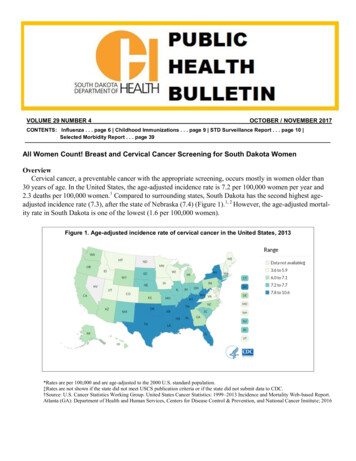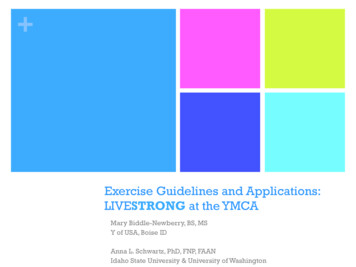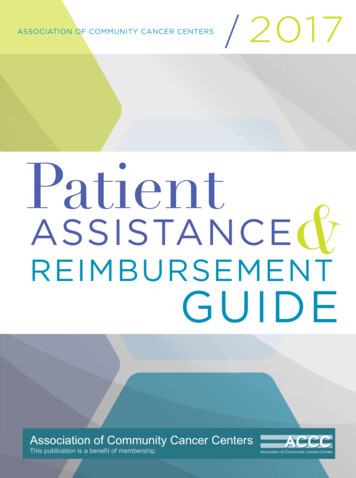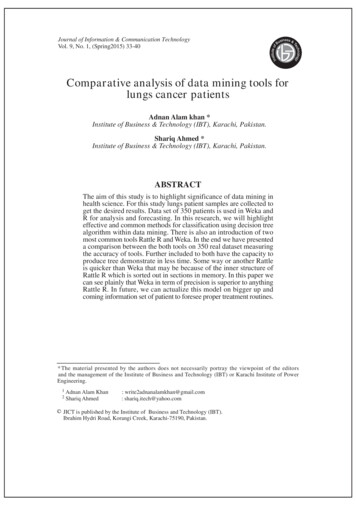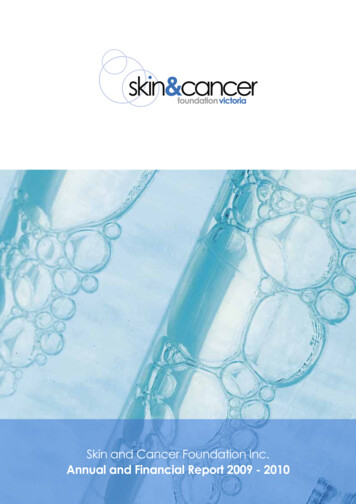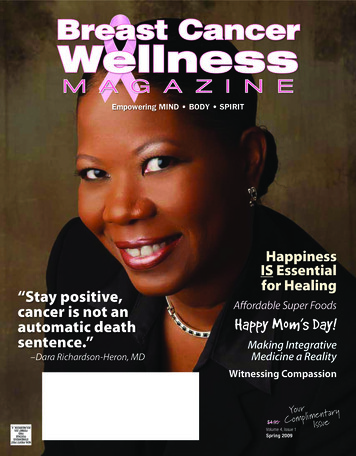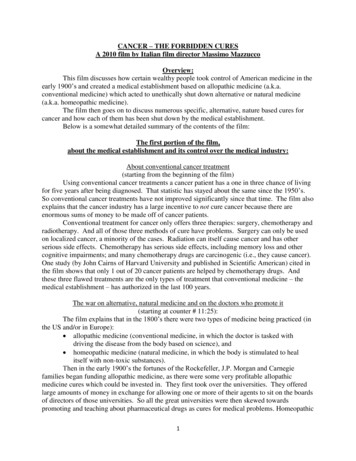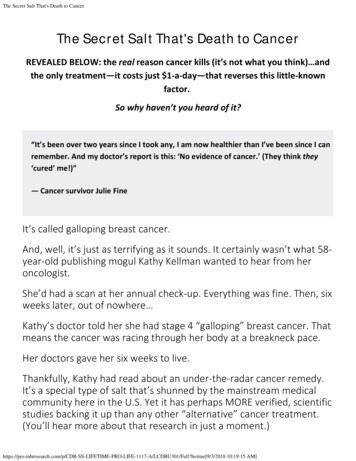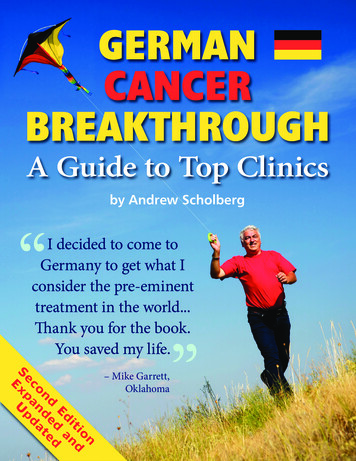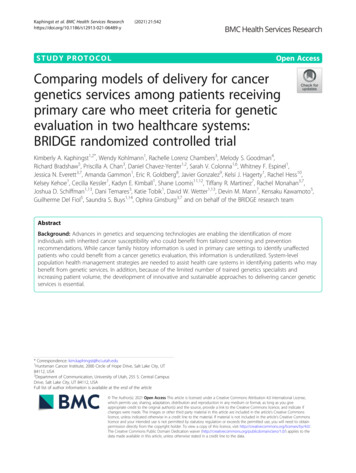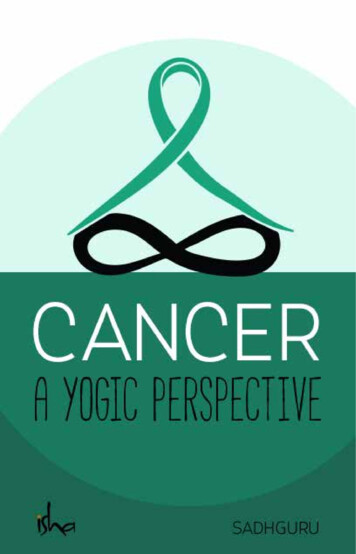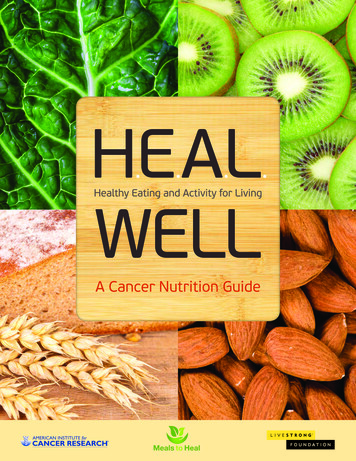
Transcription
A Cancer Nutrition Guide
HEAL Well: A CancerNutrition GuideHEAL Well: A Cancer Nutrition Guide was createdthrough a joint project of the American Institutefor Cancer Research (AICR), the LIVESTRONGFoundation, and Meals to Heal . This guideprovides general information regarding nutritionand cancer, addresses common questionspeople have about diet, nutrition, and physicalactivity during and after cancer treatment, andoffers suggestions for common cancer or cancertreatment-related symptom management.Nutrition problems that may come with cancerand cancer treatment are also covered, includingsuggestions to help manage possible eating-relateddifficulties.The information is evidence-based. This means thatit is based in scientific research. However, it is notintended to offer medical advice or replace advicegiven by your healthcare team. It is important toaddress all medical questions and concerns aboutyour care with your healthcare team.
Table of ContentsPART1234567Introduction1Diet and the Development of Cancer3Diet and Nutrition during Cancer Treatment9Dietary Supplements15Physical Activity for People with Cancer17Cancer Survivorship and Beyond21Answers to Common Questions about Diet, Nutrition,and Cancer23Resources25i
IntroductionEating a healthy diet and being physically active arevery important for people diagnosed with cancer,both during and after cancer treatment. HEAL Well:A Cancer Nutrition Guide offers practical suggestionsfor achieving the following goals after a cancerdiagnosis:Read nutrition information closely.Science progresses slowly and carefully. That iswhy when you see health products and diet plansusing words like “breakthrough,” “miracle,” oreven “discovery,” red flags should appear. Anotherwarning sign is the use of anecdotal evidence(“testimonials” or “case histories”) rather thanpublished scientific research based on results ofstudies done with many people with cancer.1. Achieve and maintain a healthy weight.2. Be physically active.3. Select and eat healthy foods and beverages thatsupply you with nutrients to nourish, repair,and heal your body.Maintain a healthy skepticism.That does not mean you have to cross check eachand every scientific study that comes along. Luckilyyou have already got the most important thing youwill need—common sense. If something sounds toogood to be true, it probably is. It is also importantto realize that science usually moves ahead byconsensus—meaning the results of a single studyare often not enough to prove a new idea. Medicalresearchers often accept a new idea as fact only aftermore than one study has obtained similar results.4. Reduce your risk of cancer coming back, thedevelopment of another cancer, and otherchronic diseases such as heart disease, Type 2diabetes, and osteoporosis.Evaluate Nutrition InformationPeople who have been diagnosed with cancer or apre-cancerous lesion tend to be highly motivatedto improve or maintain their health. Concernedindividuals often search for information by reachingout to experts, talking to friends and family, andsearching the internet. They want to find ways toreduce the risk of cancer coming back. They mayread widely and ask questions in an effort to makehealthy changes. However, cancer survivorshipresearch is still in its early stages. Dependable,science-based advice can be hard to find. Toseparate fact from fiction, there are some things tokeep in mind the next time you hear or read aboutsomething related to cancer that sounds too good tobe true.Get the whole story.Reports about science that appear in the media areoften too brief to include important details. Refer topublished articles from reputable sources and yourhealthcare team for more complete information.Look for scientific agreement based on a number ofstudies, and not just the results of one study.Here are some things to think about: 1Where was the study published? Wasthe journal peer-reviewed by healthcareprofessionals or was it published in a magazine?INTRODUCTION
Who paid for the study to be conducted? How many people were studied? certified specialist in oncology nutrition (CSO),about your diet and nutrition questions. Healthcareprofessionals with these credentials—RD, RDN, andCSO—are certified by the Commission on DieteticRegistration, the credentialing agency of theAcademy of Nutrition and Dietetics. In addition,there are board-certified physicians in surgicaloncology, medical oncology (chemotherapy), andradiation oncology. There are also board certifiedoncology healthcare professionals in nursing,pharmacy, social work, occupational therapy,and physical therapy. Talk to general healthcareproviders if you need a referral or a place to start.Oncology specialists are found in large academiccenters, medical centers, community cancer centers,and individual clinics and medical practices.How does the study relate to other research inthe same field?Did the study prove a cause or just establish anassociation?Be wary of easy answers.It is human nature to look for quick fixes that solvehealth problems, but cancer is complex. There aremore than 100 related, but separate, diseases thatare called cancer. This is a disease with no singlecause, and each individual’s experience with canceris unique.Go to a reputable source.Your oncology healthcare team can provide valuableinsights and direction in your efforts for healthyeating and ways to become more physically activeduring and after your cancer treatment. However, itis important to keep them informed about what youare taking and what diet plans you are following.These days, everyone has something to say aboutcancer, nutrition, physical activity, and health. Besure to talk with your healthcare team before tryingany new “cancer-fighting” strategy. For example,certain dietary or herbal supplements, even iflabeled “all natural,” may interact with medicationsbeing used to treat your cancer.The human body is composed of many intricatesystems that work together. Foods containhundreds, perhaps thousands, of components suchas nutrients, vitamins, and minerals. The mosthealthful strategy will always be one that addressesthe overall diet, not single foods or dietarysupplements.Healthcare professionals have many years oftraining and experience, and they work hard tokeep up with new developments. Ask to speak toa registered dietitian (RD) or a registered dietitiannutritionist (RDN), preferably one who is also aHEAL WELL: A CANCER NUTRITION GUIDE2
Diet andthe Developmentof CancerThe Link betweenNutrition and Diet and theDevelopment of Cancer1cancer, what you eat and drink, and how you livecan still help short-circuit the cancer process.What Contributes to ChronicInflammation?How Does Diet Affect Cancer?Inflammation is the body’s first response to infectionand injury. This process is essential to healing,but too much inflammation or inflammation thatgoes on for too long can damage cells and theirdeoxyribonucleic acid (DNA) or cellular geneticmaterial. This damage can lead to higher risk for thedevelopment of cancer and other diseases.Many factors influence the development of cancer.Over the last 25 years, science has shown that diet,physical activity, and body weight—especiallybeing overweight or obese—are major risk factorsfor developing certain types of cancer. Your body’sability to resist cancer may be helped by following ahealthy diet, staying physically active, and avoidingexcess body fat.Scientists have found that a constant state of lowlevel inflammation—called “chronic inflammation”—can be caused by being overweight or obese(carrying too much body fat). That is because fat cellsconstantly make inflammatory cytokines (proteinmolecules that activate immune cells).Study after study suggests that a healthful diet—one rich in a variety of vegetables, fruits, wholegrains, and legumes (beans), and low in red and(especially) processed meat—can fight cancer.Researchers have known for some time thatthis general pattern of eating provides vitamins,minerals, and protective and naturally-occurringplant substances known as phytochemicals (phyto plant) and can help to defend the body againstcancer and other diseases.Does Sugar Feed Cancer?The belief that white sugar in the diet somehow“feeds” cancer is very common, but the truth ismore complicated. All cells, including cancercells, in the body use sugar (glucose) from thebloodstream for fuel. Glucose is the primary fuelfor our bodies and our brains. Blood glucose comesfrom foods containing carbohydrates, includinghealthful fruits, vegetables, whole grains, andlow-fat dairy products. When there is not enoughcarbohydrate in the diet, some glucose is evenproduced by the body from protein-containingfoods through a special process.The scientific community has identified manynaturally occurring substances in plant foods withthe power to defuse potential carcinogens. Someof these nutrients and natural phytochemicals seekout toxins and usher them from the body beforethey can cause cell damage that may lead to cancer.Others seem to make it easier for the body to makerepairs at the cellular level. Still others may helpstop cancer cells from reproducing. Even after acell begins to experience damage that can lead toThe connection between sugar and cancer isindirect. Eating a lot of high-sugar foods may mean3DIET AND THE DEVELOPMENT OF CANCER
more calories in your diet than you need, which canlead to excess weight and body fat. It is excess bodyfat that has been convincingly linked to greater riskof several types of cancer.Guide is available at http://www.ewg.org/foodnews/summary.php/. According to the EWG, you can usethis list to reduce your exposure to pesticide residues,but they say “eating conventionally-grown produceis far better than not eating fruits and vegetables atall.” The bottom line is to eat plenty of vegetables andfruits, whole grains and beans, whether fresh, frozen,dried, cooked, or canned.Highly refined foods and foods with added sugars,such as sugary drinks and sweets, are also low infiber and low in nutrients. They add little to thediet except calories. These foods may also increaseinsulin resistance, and this has been linked to anincreased risk of developing diabetes, heart disease,and overweight and obesity.Body Weight and Its Link to CancerDevelopmentThe link between excess body fat and cancer wasone of the strongest findings from AICR’s reportand its continuous updates. These comprehensivereviews of cancer research worldwide calculatedthat approximately 117,000 cancer cases in theUnited States each year are linked to excess bodyfat. Specifically, AICR found that obesity increasesrisk for at least seven types of cancer: colorectal,postmenopausal breast, kidney, pancreatic,endometrial, gallbladder, and a common variety ofesophageal cancer called adenocarcinoma.Should I Only Eat OrganicallyGrown Foods?There are many reasons why people may prefer toeat foods grown organically with fewer pesticideresidues. Eating foods that contain pesticides couldincrease cancer risk slightly. However, studiesclearly affirm that consuming a diet rich in fruitsand vegetables, whether grown conventionally ororganically, is an important part of a diet that lowersoverall cancer risk. If you decide to purchase organicproduce, information from the EnvironmentalWorking Group (EWG) may be helpful. The EWGhas published The Shopper’s Guide to Pesticides inProduce that lists certain foods they call the “dirtydozen plus two” (non-organic fruits and vegetableswith the highest amount of pesticides) and the“clean fifteen” (non-organic fruits and vegetableswith the least amount of pesticides). The EWG’sHow Fat Cells Work and Body ShapesFat cells grow when people gain weight and shrinkwhen they lose it. Studies suggest that location offat cells in the body matters. Fat that accumulatesin the abdominal area—lending the body an “appleshape”—is often visceral fat. That means it lies deepinside the abdomen and surrounds vital organs.People with too much visceral fat have been shownto be at greater risk for developing obesity-relateddiseases and cancer. Another type of fat tissue,subcutaneous fat, is located directly beneath theskin. Sometimes subcutaneous fat is deposited at thewaist, but it’s often in the thighs and buttocks, andgives some people a “pear shape.” Studies show thatvisceral fat tissue (like belly fat) pumps out moreinflammatory cytokines and hormones like insulin,leptin, and estrogen. Elevated levels of all thesesubstances are associated with higher cancer risk.There are two easy methods for assessing body fat.While these methods are not perfect, they can helppeople assess whether their weight and waist sizefall within the healthy range.HEAL WELL: A CANCER NUTRITION GUIDE4
BMI ChartHeightWeight in Pounds (without clothes)4'11''94 3242526272829303540BMI may not be an accurate measure for everyone—including people who have more muscle mass (like athletes), older adultswith less muscle mass, or people under 5 feet tall.To use the table, find your height in the left-hand column. Locate your weight (in pounds) to the right.The number at the bottom of that weight column is the BMI for your height and weight.Body Mass Index (BMI)Waist CircumferenceBody Mass Index is a way to measure overweightand obesity. BMI is a measure of body fat basedon a person’s weight and height. Staying withinthe healthy range throughout life is important forlowering cancer risk.Waist circumference is another method of assessingbody weight and is particularly sensitive toaccumulation of visceral fat. Use a measuring tapeand follow these easy steps:Place a tape measure around the waist above the tipof the hipbone.There are five BMI categories: Underweight: Below 18.51. Measure the waist after exhaling. Healthy Weight: 18.5 to 24.9 Overweight: 25.0 to 29.92. Use the following measurements to determinehealth risk. Obese: 30.0 to 39.9 Extremely Obese: 40.0 and above For women, a waist measurement of 31.5inches or more indicates increased health risk. For men, a waist measurement of 37 inchesor more indicates increased health risk.5DIET AND THE DEVELOPMENT OF CANCER
Diet and Nutrition’s Impactat the Molecular LevelFor Cancer Prevention AICRRecommends:Be as lean as possible within the normal range ofbody weight: Phytochemicals and AntioxidantsMaintain body weight range within the normalBMI range, starting from the age of 21.Phytochemicals have the potential to stimulatethe immune system, slow the growth rate ofcancer cells, and prevent DNA damage that canlead to cancer. The word “phytochemical” meansa naturally occurring plant (phyto, in Greek)chemical. Phytochemicals provide a plant withcolor, aroma, and flavor as well as protection frominfection and predators. The colors, fragrances,and taste of the plant hint at the phytochemicals itcontains. In the human diet, some phytochemicalswork together to protect the body from cancer andother diseases.Avoid weight gain and increases in waistcircumference through adulthood.Avoid foods and drinks that promote weight gain: Consume energy-dense foods sparingly (highcalories for amount and few nutrients).See Box: What Are Energy Dense Foods? Avoid sugary drinks. Consume “fast-foods” sparingly, if at all.Many phytochemicals work as antioxidants.Antioxidants are compounds that protect the body’scells from oxidative damage—which can come fromthe water we drink, the food we eat, and the air webreathe. Preventing this type of damage might helpprotect us from cancer and other diseases. A steadysupply of antioxidants from our food is needed toprovide protection because of the body’s continuousproduction of oxidative damage. The best way toprovide the body with phytochemicals is to eat abalanced diet that includes whole grains, legumes,nuts, seeds, and a variety of colorful fruits andvegetables.What Are Energy-Dense Foods?* Sugary drinks—soft drinks, sweetened icetea, juice flavored drinksBaked goods such as desserts, cookies,pastries, and cakes Candy Chips such as potato and corn Ice cream, milkshakes Processed meat—hotdogs, salami,pepperoniAICR Recommends:Fast food such as French fries, friedchicken, and burgers Eat mostly foods of plant origin:Packaged and processed foods high inadded sugars and fats*Foods containing more than 225–275 caloriesper 100 grams (3 ½ ounces)HEAL WELL: A CANCER NUTRITION GUIDE 6Eat at least five portions/servings of a varietyof non-starchy vegetables and fruits every day.Examples of a serving: 1 cup raw or cookedvegetables or 1 medium apple.Eat whole grains and/or legumes (beans andlentils) with every meal.
Colorful Fruits, Vegetables, and PhytochemicalsColorPhytochemicalsWhite andgreenAllyl sulphidesGreenSulforaphanes, indolesYellowand greenLutein, zeaxanthinOrangeand yellowCryptoxanthin, flavonoidsOrangeAlpha and beta carotenesRedand purpleAnthocyanins,RedLycopeneFruits and VegetablesOnions, garlic, chives,leeksBroccoli, Brussels sprouts,cabbage, cauliflowerAsparagus, collard greens,spinach, winter squashCantaloupe, nectarines,oranges, papaya, peachesCarrots, mangos,pumpkinBerries, grapes, plumspolyphenolsTomatoes, pinkgrapefruit, watermelon7DIET AND THE DEVELOPMENT OF CANCER
Colorful Fruit and Vegetable RecipesAcorn Squash and Apple SoupHoliday Quinoa Salad withPomegranate and Fresh Herbs1 medium acorn squash1 Tbsp. canola oil1 medium onion, chopped1 leek (white part only), rinsed well and chopped1 tart apple (such as Granny Smith), peeled, cored,and chopped3 cups fat-free, reduced-sodium chicken brothMilk or additional broth to thin soup (optional)Salt and freshly ground black pepper, to taste3 Tbsp. minced fresh mint leaves, as garnish¾ cup quinoa1¾ cups water¾ tsp. kosher or sea salt, divided½ medium Fuji apple, cored and finely chopped½ cup fresh pomegranate seeds1/3 cup finely chopped cilantro¼ cup finely chopped fresh mint¼ cup finely chopped flat-leaf parsley1/3 cup finely chopped scallions, green and white parts¼ cup blood orange juice or orange juice plus 1teaspoon lemon juiceFreshly ground pepper2 tsp. extra virgin olive oilPreheat oven to 375 degrees. Cut acorn squash inhalf length-wise, remove seeds. Set on a rimmedbaking sheet. Bake until the flesh is tender whenpierced, roughly 45 to 90 minutes (depending onsize). Remove squash from oven and allow to cool.Rinse quinoa in strainer, drain well, and placemoist grain in heavy, medium saucepan. Cook overmedium-high heat, stirring constantly with woodenspatula until grains stick to bottom of pot and thenstart to move freely and smell toasty, about 5 minutes.When grains of quinoa start to pop, move pot offheat and pour in 1¾ cups water, standing back asit will splatter. Immediately return pot to heat andreduce heat to medium. Add 1/4 teaspoon salt, cover,and simmer for 15 minutes, or until quinoa is almosttender. Off heat, let grain sit, covered, for 10 minutes.Using fork, fluff quinoa, and transfer it to mixingbowl. There will be about 2 1/4 cups cooked quinoa.While the squash is cooling, in a large, heavy panheat the canola oil over medium-high heat. Add theonion and leek and sauté for about 4 minutes, untilthe onion is translucent. Add the apple and cook overmedium heat for 1 minute.Scrape out the squash pulp and combine with theapple mixture. Reduce heat to medium-low, coverand cook for 5 minutes, stirring often. Add the brothto the pan, cover and bring to a boil over high heat.Reduce the heat to low and simmer for about 30minutes. Remove the pan from heat and set the soupaside to cool slightly.Let quinoa sit until it is room temperature. Add apple,pomegranate seeds, cilantro, mint, parsley, andscallions to grain and, using a fork, mix to combinethem.In a blender or food processor, purée the soup inbatches until smooth. Return soup to pan and heatjust before serving. Add milk or additional broth tothin soup, as desired. Season to taste with salt andpepper. Garnish each serving with mint and serve.In small bowl, whisk blood orange juice, or twocitrus juices, with remaining 1/2 teaspoon salt untilit dissolves. Add 4-5 grinds pepper, then whisk inoil. Pour dressing over salad and toss with fork todistribute it evenly. Serve within 2 hours. The quinoaand dressing parts of this salad can be made up to 8hours ahead, then covered and refrigerated separatelyand combined shortly before serving.Makes 5 servings.Per serving: 103 calories, 3 g total fat ( 1 g saturatedfat), 18 g carbohydrate, 3 g protein, 3 g dietary fiber,330 mg sodium.Makes 4 servings.Per serving: 179 calories, 4 g total fat ( 1 g saturatedfat), 32 g carbohydrate, 5 g protein, 3 g dietary fiber,366 mg sodium.Reprinted from the American Institute for Cancer Research.HEAL WELL: A CANCER NUTRITION GUIDE8
Diet and Nutritionduring CancerTreatment2Good Nutrition DuringCancer TreatmentCancer treatment can place a lot of nutritionaldemand on your body. It is important to try toconsistently consume a healthy diet and to drinknourishing beverages. The main nutritional goalsduring this time are to maintain a healthy weightand eat healthy foods that supply your body withcalories and nutrients for energy, repair, recovery,and healing. A healthful eating pattern includesplenty of vegetables and fruit, moderate amountsof whole grains, and plant protein sources like nuts,beans, lentils, tofu, and tempeh, along with modestportions of fish, poultry, lean meats, and nonfat orlow-fat dairy foods.The New American PlateAICR’s “The New American Plate” is avaluable resource that shows how to eat in away to lower cancer risk and to manage bodyweight. More information is available athttp://www.aicr.org/new-american-plate/ orby calling 800-843-8114.See pages 21-22 for AICR’s specific recommendations for healthy eating and physical activity forreducing risk of new and recurrent cancers.Treatment Side EffectsThat Can ImpactNutritional Well-BeingChoose My PlateThe United StatesDepartment ofAgriculture’s“ChooseMyPlate” isanother easy-to-useresource to help peopleplan their own healthy diet. Use the followinglink to learn more about this website:http://www.choosemyplate.gov/.Side effects of cancer therapy may affect your eatinghabits and nutritional status. The following pagescontain suggestions for managing common eatingdifficulties during and after treatment.9DIET AND NUTRITION DURING CANCER TREATMENT
Changes in Appetite andUnwanted Weight LossNausea and VomitingNausea and vomiting can be caused bychemotherapy or from radiation therapy to thestomach, abdomen, or brain. Being nauseated orvomiting because of cancer treatment can make itdifficult for a person to eat and drink.Loss of appetite is common in people with cancerand can lead to weight loss and undernutrition(malnutrition). Poor nutrition can slow the body’sability to heal. Severe malnutrition can interferewith proper functioning of the heart, liver, kidneys,and immune system.Try these ideas for managing nauseaand vomiting:Try these ideas for improving your appetiteand maintaining calorie and protein intakeduring cancer treatment: Eat five or six smaller meals per day. Eat the largest meal when you are hungriest. Start with high-protein foods while yourappetite is strongest. Keep favorite high-calorie foods and beverageswithin easy reach. Try to be as physically active as you are able tobe to help stimulate your appetite. Enlist the help of your loved ones and caregiversto help with purchasing and preparing food. Ask to talk with a registered dietitian forpersonalized help.In certain situations, your doctor may prescribea medication to help improve your appetite. Eat small amounts of food more often.Small portions of meals and snacks are oftenmore easy to tolerate than large.Eating foods and sipping on clear liquids at roomtemperature or cooler may be easier to tolerate.Avoid high-fat, greasy, spicy, or overlysweet foods.Avoid foods with strong odors.Sip on beverages between meals rather than withmeals.Eat sitting up and keep head raised for about anhour after eating.For vomiting, avoid eating or drinking untilvomiting is controlled—then try sipping onsmall amounts of clear liquids such as cranberryjuice or broth. Nibbling on plain foods such aspretzels or crackers may also help.Take anti-nausea medicine as prescribed. Ifit is not controlling symptoms, contact thehealthcare professional that prescribed the antinausea medicine, and let him or her know whatis happening.Evaluate if you are feeling indigestion or refluxversus nausea. Discuss your symptoms with yourhealthcare professional as treatment options foreach condition vary.FatigueFatigue is the most common side effect for thosediagnosed with cancer. It can be related to thecancer itself or can be one of the effects of cancertreatment. Eating regularly and being as physicallyactive as you are able may help to relieve yourfatigue and enhance your mood.HEAL WELL: A CANCER NUTRITION GUIDE10
Try these ideas for managing diarrhea: Try to drink plenty of fluids. Being dehydrated can make fatigue worse. Eat small amounts of soft, bland foods. Considera diet that consists of water soluble fibercontaining foods such as bananas, white rice,applesauce, and white toast.Decrease intake of high fiber foods during thistime. These include foods containing nuts andseeds, raw vegetables and fruits, and whole grainbreads and cereals.Eat small amounts of food throughout the dayrather than fewer large meals.Take anti-diarrhea medicine as prescribed. If themedicine is not controlling the diarrhea, call thehealthcare professional that prescribed the medicine.Constipation can be a symptom of the canceritself or it can be caused by medicines used totreat cancer or manage pain. Constipation is whenbowels do not move regularly and when stoolsbecome hard and difficult to pass.Try these ideas for managing fatigue: Drink plenty of liquids such as water, clearjuices, sports drinks, broth, weak tea, or oralrehydration solutions (available over-thecounter at most pharmacies).Temporarily rely on ready-to-eat foods likefrozen dinners, fruits, and vegetables.Prepare food when you feel your best and freezeleftovers in meal-size portions.Try these ideas for managing constipation:Try to drink plenty of fluids. Being dehydratedcan make fatigue worse. Aim for at least 8 cupsof hydrating fluid each day unless advised torestrict fluids for another medical condition.Hydrating fluids include water, clear juices,sports drinks, broth, or weak tea. Accept help with meals from friends and familymembers. Check for delivery services like Mealson Wheels (available at http://www.meals-onwheels.com/) or a home delivery meal servicesuch as Meals to Heal (available athttp://meals-to-heal.com/ or 888-721-1041). Bowel Changes:Diarrhea and Constipation Diarrhea can be caused by the cancer itself, certainchemotherapy agents and medicines, or becauseof radiation therapy to the abdomen and pelvis.Diarrhea is having frequent and loose watery stools.11Drink more healthy beverages to help keep yourdigestive system moving, especially water, prunejuice, warm juices, decaffeinated teas, and hotlemonade.Increase intake of high fiber foods such as wholegrains, fresh and cooked vegetables, fresh anddried fruits, and foods containing peels, nuts,and seeds.Work with your healthcare team to set up anindividualized bowel regimen. This programmay include stool softeners and gentle, nonhabit forming laxatives.Increase your physical activity as you are able,such as taking a walk or doing limited exerciseevery day. Ask your healthcare team how muchexercise is right for you.DIET AND NUTRITION DURING CANCER TREATMENT
Changes in Taste and Smell Changes in taste and reactions to smells arecommon problems that can happen whileundergoing and recovering from cancer treatment.These changes can affect your desire to eat. Try these ideas for managing taste andsmell changes: Choose foods that appeal to you. Often, moistand naturally sweet foods such as frozen melonballs, grapes, or oranges work well. Some findtart foods and beverages appealing.Try eating cooler temperature foods, ratherthan hotter temperature foods, as they have lessaroma and taste. Try marinades and spices to mask strange tastes.Red meat often becomes less appealing, so trypoultry, fish, beans, nut butters, or eggs.Brush your teeth and tongue and rinse yourmouth regularly, especially before eating.Rinse your mouth several times a day with 1 to2 ounces of a homemade salt and baking sodasolution (one quart of water combined with oneteaspoon of salt and one teaspoon of bakingsoda) or an alcohol-free mouth rinse. Try to focus on foods naturally low in caloriesand high in fiber to help you feel full, such asvegetables, fruits, whole grains, and beans.Include small amounts of higher calorie foodsthat you enjoy most, and be sure to savor themfor the most satisfaction.Pay attention to portion sizes and fill most ofyour plate with lower calorie plant foods.Eat only when you are physically hungry.Try to get regular physical activity to helpyou reduce fatigue, control weight gain, andimprove mood.Eat soft, moist foods with extra sauces, dressings,or gravies.Avoid dry, coarse or rough foods.Avoid alcohol, citrus, caff
Nutrition Guide. HEAL Well: A Cancer Nutrition Guide. was created through a joint project of the American Institute for Cancer Research (AICR), the LIVE. STRONG. Foundation, and Meals to Heal . This guide provides general information regarding nutrition and cancer, addresses common questions people have about
